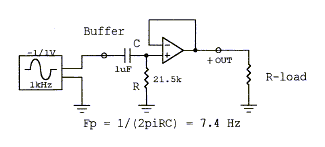That is a class a preamp and I think you'll like it. The gain is set lowest, 4.3X but you could increase the preamp gain and decrease the power amp gain. That could be beneficial.Plz check these buffers, actually i like the one posted. Plz recommend me a good buffer.
Building a buffered Gainclone chip amp.
The circuit is a bit more fascinating than it first appears. Nick said: ". . . the 5534's having a little more 'slam'" which is some indication that you don't need to add an input buffer while using this preamp. He used authentic Signetics/Philips parts while making the performance observations. Results may be different if a clone chip is used.
It is probably 2.2u. Getting the rail2rail cap to work can be hit or miss, so just try it and see if the midrange is slightly clearer and if the midrange is slightly less loud and if the heatsink is slightly cooler. If the rail2rail filter is working, it should do one or more of those benefits.I have bought some polyester caps ,,he says it is 2.2 uf.It reads as 2.2K250VAC,,,Is this 2.2uf..Any idea?I wanna used it for rail2rail.
Alternative use of 2.2u polyester caps: Add 50R variable resistor series to make an adjustable RC and then snub your transformer secondaries. That's very effective.
That sort of buffer is unlikely to be needed. Except for acting like a wire, it puts in noise and degrades audio resolution. I'm sure you'd prefer an ordinary wire instead of that thing.May be I just need a simple buffer like one of these.
P.S.
A preamp could be a lot more fun--the TDA729X plays more clearly when set to lower gain, but then you'd need a preamp. Yeah, go for a preamp. A Class A preamp would be nice.
Last edited:
They can be metal oxide or even wirewound can work.Yes my 1.5, 1W X6 looks likes a fish net. They are kinda thick. I will change to single .25R or .3R around 5 W should they be metal oxide ?
That is voltage amplifier stage, much like pin 11 on TDA7293. With that feature on NE5534, there's a variety of things you could do with it, such as make a headphone amp: diy simple NE5534 promote transistor amp circuit graphicsimply14prem said:I'm stuck at what to connect between pin 5 and 8, of NE5534
For our application, BC550, BC560 would be suitable output devices for the preamplifier if you wanted a class AB preamplifier (but we do not).
The Signetics, Raytheon, Philips NE5534 has 3 pins that can bypass the internals, so that the chip is actually a "kit" that can build a really wide variety of devices.
There's another thing possible--with just 2 fets you can upgrade the input devices to something finer than any op-amp.
Basically, by activating the upgrade path built into the NE5534 and adding the extra parts, you end up with a Super-Op-Amp like the Burson.
Instead of replacing the output devices, we're biasing the internal output devices of the NE5534/TDA1034/RM5534 to Class A so there's no crossover noise at all.
Theoretically, there's an easier way to do it with pin 5 and a 1m or 470k resistor because if you bias the vas it will bias the outputs too, but I cannot find the documentation on that. If using the advanced features of NE5534, fakes/clones such as TI, NatSemi, OnSemi and JRC/NJM may latch up in some applications, because the clones are "almost" the same, meaning they're not really authentic.
The good news is that the external bias shown at Decibel Dungen is generally compatible and doesn't rely on using the hidden features in the NE5534. In this case, the answer to your question is "compensation cap" and you probably don't need it if the schematic doesn't call for it.
Last edited:
Fairchild Stealth are suitable, well behaved in linear supplies and extremely fast, but 8 of them are more difficult to install than a pair of KBPC1004's.
How about using 4 dual series diodes? Tie/glue/bolt two of them toghether, bend and solder the anodes and the cathodes, and there you have a bridge. Very p2p, if you ask me. Fairchild Stealths are available in dual series package.
You could try raising the gain of preamp and then adding a resistor for global negative feedback from the output of the power amp to the inverting input of the preamp. See also composite, nested designs. Check for DC offset before connecting speaker. A composite design with a Class A preamp will force the power amp to sound like Class A, in proportion to the added global negative feedback.
Question: Did you have the 4.7u output cap of the preamp in series with the 1u input cap of the TDA729X?
Question: Did you put a potentiometer or other disturbance between preamp and power amp?
I have no 4.7uf after preamp.I have two 2.2+--+2.2 uf as input cap in TDA7294.I have 10K pot for Tda7294.
You could try raising the gain of preamp and then adding a resistor for global negative feedback from the output of the power amp to the inverting input of the preamp. See also composite, nested designs. Check for DC offset before connecting speaker. A composite design with a Class A preamp will force the power amp to sound like Class A, in proportion to the added global negative feedback.
Sorry that is way advanced from me.I can't understand it.
- Home
- Amplifiers
- Chip Amps
- Point 2 Point (no PCB) for TDA7293, TDA7294, TDA7295, TDA7296.
